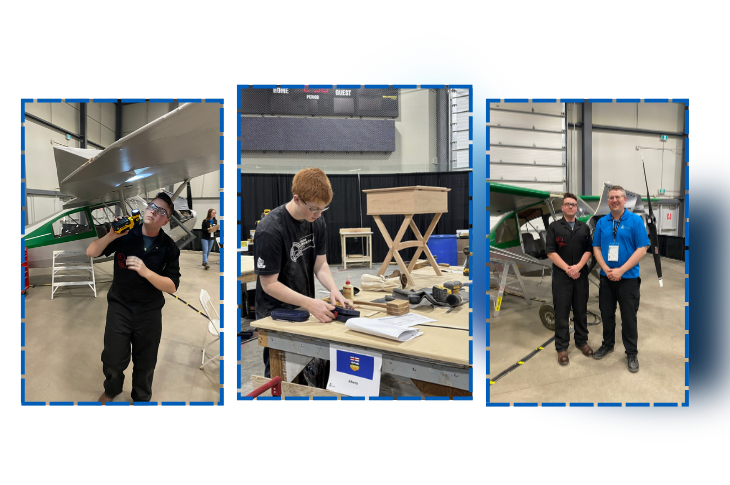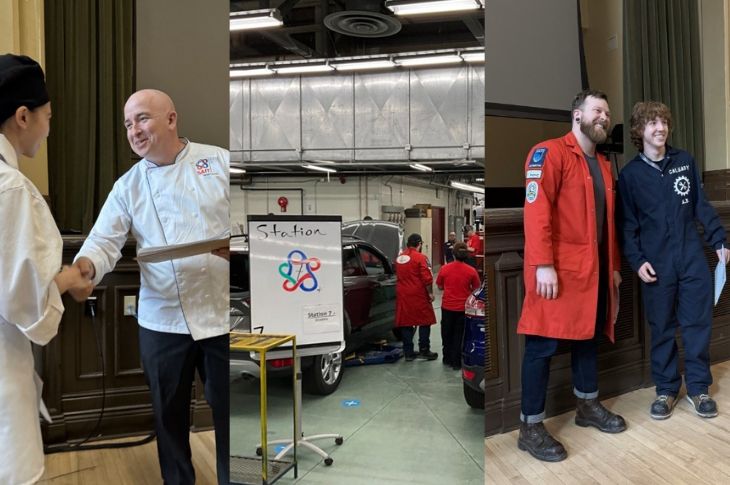How to be the best in a skill and prove it

Skills competitions are the ultimate resumé boost and badge of excellence.
You enter a building buzzing with booths and hundreds of people.
You’re a Skills competitor, highly trained to work in your field.
The kicker? You’re not even 25 but you already boast abilities to impress even seasoned vets.
In this competition, the finish line is not a white line on the ground, but instead a company logo, three-course meal or a bathroom plumbing setup built to specific standards — depending on your field.
The air smells like cookies and sawdust. Metal clangs, machinery whirrs, and then the hum of noise falls away as you pass the Skills area dedicated to computer and tech-related work.
Once you arrive at your station, nerves and excitement collide, reminding you of the many hours, months, years spent training for this moment.
You’re given the materials and tools for your assignment, then every minute counts as you complete the challenge — because the clock runs out in a day or two.
You’re locked in.
You work for hours, and the result is judged by experts who study, evaluate and score what you’ve produced.
Then it’s time to celebrate. The winners are recognized with bronze, silver and gold medals.
If you win gold, like SAIT student Tate McGarry and alumnus Ben Jamison, another competition awaits after the medal ceremony.
After taking the title at the 2025 provincial and national level competitions, Tate and Ben are headed to the 48th WorldSkills competition in Shanghai, China in 2026. Tate is in his second year of the Cabinetmaker apprenticeship and Ben graduated from SAIT’s Aircraft Maintenance Engineers Technology program two years ago.
Both are spending the next year training in their areas to reach a new level — best in the world.
You too can learn how to be the best with this blueprint inspired by Tate’s and Ben’s experiences and training routine. No matter the trade, lessons learned through Skills competitions can apply to your own personal and professional goals. Spoiler alert: being the best in the world can also land you your dream career. ⬇️
Step one: Choose the skill you want to learn

Though it may seem obvious, it’s much easier to put in the work and time for something when you enjoy the process. Identify the hobbies that come easily to you, because they might incorporate specific skills which could lead to a career path.
Before taking a carpentry class in Grade 10, Tate helped his dad with a few projects around the house.
“The next year I switched to cabinetmaking because I thought it would be a better fit,” says Tate.
He gave cabinetmaking, the intricate little brother of carpentry, a go and never looked back, realizing working on projects with smaller details interested him more. That led him to the cabinetmaker apprenticeship at SAIT.
His first big project was a coffee table but now he’s creating intricate campaign tables (such as the antique-style desk pictured above), with overlays and dovetail joints, flexing skills only well-seasoned cabinetmakers might be expected to possess.
“You need an eye for detail and patience,” he says, describing a person who might find themselves enjoying that kind of work.
#DYK? Skills competitions start in high school!
SAIT hosts regional skills competitions for high school students. It’s where Tate got his first taste of Skills. It’s also a good way for youth to become familiar with the SAIT campus even before graduating.
Imagine teens dragging their parents to school, not the other way around!

As a child, Ben was in the air cadets program, which drew him to aviation. He enjoys tinkering with things and understanding how they work.
“I discovered aircraft maintenance was a possibility and that’s a perfect fusion between aviation and mechanics, which is what I was looking for in a trade.”
In his world, mechanics and engineering come together to ensure planes and helicopters are fit to fly. Tasks include troubleshooting electrical components, inspecting engines, repairing composite and pounding rivets into sheet metal, among others.
As for Harold Bergmann, SAIT instructor and Tate’s trainer, choosing your interest is the advice he gives.
“I tell my boys and my daughter, ‘If you find something you love to do, you won’t hate going to work.’”
Ask yourself this 🤔
Do I suddenly feel engaged and interested when this skill comes up in conversation? Do I look it up and search for opportunities to learn more?
If you answered yes and yes, consider working that skill until you reach excellence.
Step two: Practice makes perfect

Once you discover the skill you want to master, it’s time to do it. Not once or twice, but as many times as you need until the tools and techniques of the skill become familiar and you enter that flow state of creation.
Apprenticeships reflect this principle, since they combine classroom instruction and on-the-job training. Adding on the layer of Skills competitions pushes apprentices even further, beyond what they might know is possible. The output of Skills projects may be more detailed than tasks requested at the job site. The time frame to complete them is also likely shorter.
As part of his training, Tate built projects similar to the ones he’d face during the provincial and national competition.
He’d bring the completed practice version into SAIT to have his trainer take a look and provide feedback.
“In Skills, you have to do good work quickly,” says Tate. “We worked through some of the processes, like better ways to do certain things.”
For example, Harold suggested grouping two legs of a campaign table together into one layout for cutting, as opposed to working on each leg individually, a more time-consuming task. He also taught Tate about the art of veneering, a unique way to imprint designs on wood.
Since Ben has already graduated, his practice time will be balanced with his work schedule at STARS Air Ambulance, where he maintains first-responder helicopters.
“I can prepare and train for composite work by just vacuum-bagging fiberglass over and over again or with sheet metal by just pounding in thousands of rivets,” he explains. “There’s lots of getting it perfect — and then doing it 1,000 more times.”
Ask yourself this 🤔
How much time can I devote to practicing this skill every day or every week? Am I willing to receive feedback from someone who’s done this more than me?
Step three: Find a mentor

Running a marathon in a fast time or hitting an ace in volleyball requires technique and structured training — often thanks to a great coach.
No high-level sport is truly individual. The same goes for Skills — there’s the competitor, the trainer and the expert familiar with the competition.
Both Tate and Ben will receive the experience and insight of Skills trainers and experts as they prepare for China. These trainers — Harold for Tate and Ryan Gillis, his co-worker at STARS, for Ben — also have insights to provide on WorldSkills, having experienced that global level of competition.
Harold has been involved in Skills since 2007 and has been a WorldSkills expert in Cabinetmaking since 2020.
He’s found combining the wood trades and teaching is the perfect mix.
“It’s been so much fun. The past 20 years have flown by,” he says.
Harold has accompanied competitors around the globe for WorldSkills, travelling to Brazil, the United Arab Emirates, France, Switzerland, Russia, and more.
The trainer is the frontline mentor who works most closely with the competitor until they reach the competition. The trainer provides opportunities for the competitor to practise and receive consistent feedback, facilitating progress. When Harold evaluates Tate’s work, he’s sure to highlight the strengths of the work and provide ideas on what could use refining.
“As a trainer, you’re the most important person in the training cycle,” he says. “It’s not just the practical skills, but it’s also the competition skills and the mental strength you need to work on as well.”
The two developed a broad training program leading up to WorldSkills together, which will evolve as time progresses.
His training plan for Tate includes different training blocks that ramp up to the competition. The plan incorporates intensity in some months and allows time for rest too. In Tate’s case, this intensity will increase as he looks to participate in a competition abroad. Once that completes, there is a period of reduced training, which will pick up again in the months leading up to WorldSkills. In the summer of 2026, a few mock competitions will provide Tate with a similar environment to what he’ll face in China.
Remember, when learning a skill, success truly is a team effort.
Ask yourself this🤔
Who do I look up to who’s already teaching or involved in the space I enjoy?
Step four: Flex your ability in a competition

Once the skill’s been practiced, trained and familiarized, it’s time to test it.
Like a runner signs up for a marathon, consider registering for an event to evaluate your skill. The new environment may sound intimidating, but it’s an effective way to see whether you can perform under pressure and time constraints.
“Skills is a-once-in-a-lifetime kind of thing,” says Ben. “It’s a fun competition.”
Meeting others who are equally interested in the same skill gets you outside of your typical working space.
It’s also a great addition to a resumé. Through Skills, Ben found work in aircraft maintenance (specifically helicopters) with STARS.
Industry partners are heavily involved in Skills competitions, often as key supporters of the events or individual competitors. If a goal of developing a new skill is a new career, Skills competitions can connect to one.
While a competitive environment may seem daunting, it’s possible to build the mental resilience required to succeed, which comes from confidence, from knowing you’ve put in the work.
“If you have a way of doing it, even if it’s different, trust your training,” says Harold.
Young people with less confidence might look to what someone else is doing and mimic their process. Though Harold doesn’t recommend trying something new for the first time at the competition.
“A good mentor will recognize when their competitor is losing focus or getting frustrated, help them recognize what’s going on and come up with strategies to deal with that.”
Those mental skills are built up during training as well, which help with the pressure and anxiety of the competition.
“Each competitor is a little different, so it’s about building them up, helping them recognize they’re here for a reason. They’ve put in the effort, the time and training. Now it’s just a matter of putting it all together.”
As for Tate, it’s about getting in the zone.
“You block all the competitors out and just work away on your project,” he says.
Learning a skill is a new opportunity to grow in more ways than one, and Skills competitions provide a space for young people to go further than they might currently think possible. The competition’s ties to industry are also a chance to discover exciting career opportunities along the way.
Take the trades to the next level with skills
Both Tate and Ben would recommend Skills competitions to a friend.
- Achieve excellent work before you turn 25? ✔️
- Boost resumé? ✔️
- Travel around the country and potentially the world? ✔️
Many futures are possible in both the trades and technology world through Skills.
Skills competitions

Oki, Âba wathtech, Danit'ada, Tawnshi, Hello.
SAIT is located on the traditional territories of the Niitsitapi (Blackfoot) and the people of Treaty 7 which includes the Siksika, the Piikani, the Kainai, the Tsuut’ina and the Îyârhe Nakoda of Bearspaw, Chiniki and Goodstoney.
We are situated in an area the Blackfoot tribes traditionally called Moh’kinsstis, where the Bow River meets the Elbow River. We now call it the city of Calgary, which is also home to the Métis Nation of Alberta.